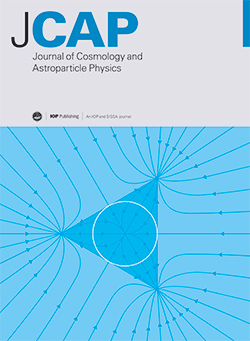Doppler bias: impact of peculiar velocities on color selection and the large scale structure of galaxy surveys
IF 5.3
2区 物理与天体物理
Q1 ASTRONOMY & ASTROPHYSICS
Journal of Cosmology and Astroparticle Physics
Pub Date : 2025-03-25
DOI:10.1088/1475-7516/2025/03/059
引用次数: 0
Abstract
Lightcone selection effects on cosmic observables must be precisely accounted for in the next generation of surveys, including the Dark Energy Spectroscopic Instrument (DESI) survey. This will allow us to correctly model the data and extract subtle shifts from general-relativistic effects. We examine the effects of peculiar velocities on color selection in spectroscopic galaxy surveys, with a focus on their implications for the galaxy clustering dipole P1(k). Using DESI Emission Line Galaxy (ELG) targets, we show that peculiar velocities can shift spectral emission features into or out of filter bands, modifying galaxy colors and thereby changing galaxy selection. This phenomenon mimics the effect of evolution bias, and we refer to it as the Doppler bias, bD. The Doppler bias is of comparable size to the evolution bias at 0.8 < z < 1, where it is largest. This enhances the ELG-LRG (Luminous Red Galaxy) cross-correlation dipole by 25–50%. This could be detectable at the ∼ 6σ level for the full DESI survey. Additionally, we found that our bD estimate is impacted by the incompleteness of the parent ELG sample. Therefore, this work highlights the essential need for careful consideration of spectral-dependent biases caused by peculiar velocities during the selection phase of galaxy surveys, to enable unbiased analyses.求助全文
约1分钟内获得全文
求助全文
来源期刊

Journal of Cosmology and Astroparticle Physics
地学天文-天文与天体物理
CiteScore
10.20
自引率
23.40%
发文量
632
审稿时长
1 months
期刊介绍:
Journal of Cosmology and Astroparticle Physics (JCAP) encompasses theoretical, observational and experimental areas as well as computation and simulation. The journal covers the latest developments in the theory of all fundamental interactions and their cosmological implications (e.g. M-theory and cosmology, brane cosmology). JCAP''s coverage also includes topics such as formation, dynamics and clustering of galaxies, pre-galactic star formation, x-ray astronomy, radio astronomy, gravitational lensing, active galactic nuclei, intergalactic and interstellar matter.
 求助内容:
求助内容: 应助结果提醒方式:
应助结果提醒方式:


